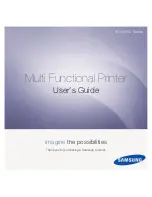
1
2
3
4
5
6
7
8
8-7
P
Paper feed
Refers to guiding a sheet of paper into the machine’s paper path.
Paper feeder
The device in the machine that feeds recording media into the
machine for printing copied or faxed documents.
Pause
A timing entry required for registering certain long distance
numbers and for dialing out through some telephone systems or
switchboards. Pressing [Pause] enters a pause between digits of
a telephone number.
PHOTO
The document setting you use for sending or copying documents
with intermediate tones, such as photographs.
Protocol
A set of rules that govern the transmission of data across a
network. Examples of protocols are FTP, DHCP, BOOTP, RARP,
IPP, and TCP/IP.
– FTP: File Transfer Protocol. A client-server protocol allowing a
user to transfer files on one computer to and from another
computer over a TCP/IP network. The File Transfer Protocol
also governs the client program with which the user transfers
files.
– DHCP: Dynamic Host Configuration Protocol. A protocol which
automatically specifies the network settings of a client on a
TCP/IP network. Many of the settings required to set up TCP/
IP, which is the standard protocol of the Internet, can be made
automatically.
– BOOTP: BOOT strap Protocol. A protocol that enables a client
machine to automatically obtain network setup information
from a server over a TCP/IP network. BOOTP enables a client
to automatically locate such information as the host name,
domain name, and IP address, so that it is not necessary to
create these items manually.
– RARP: Reserve Address Resolution Protocol. A protocol which
associates a network adapter address (MAC address) with an
Internet Protocol (IP) address.
– IPP: Internet Printing Protocol. A protocol used between a
client and a print server for carrying out remote printing over
the Internet.
– TCP/IP (Transmission Control Protocol/Internet Protocol): The
protocol used to connect to the Internet and to wide area
networks.







































